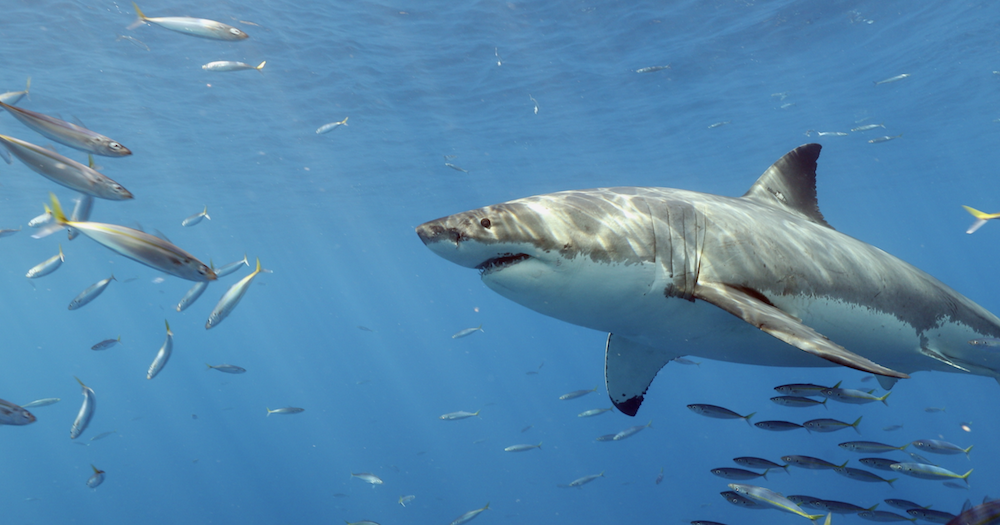Great white shark conservation is the broad effort to study and protect this particular species of shark, so that they can escape extinction. But, are great white sharks actually endangered? Read on to find out the answer to this question and more.
Pop culture generally depicts sharks, especially great white sharks, as terrifying man-eating predators – (thanks Jaws!). While great white sharks can look intimidating and are impressive ocean predators (they can be 21 feet/6.5 meters long with many serrated teeth), they should not be thought of as monsters. These misunderstood creatures are extraordinary fish! However, even predators are not immune to the threat of extinction. Below we’ll discuss some facts about great white shark conservation most people don’t know.

Are great white sharks endangered? What is their conservation status? The International Union for Conservation of Nature (IUCN) Red List of Threatened Species lists great white sharks as vulnerable, one category above endangered. The IUCN examines population trends and habitat conditions to assess the health of global biodiversity and the risk of species for global extinction.
Species are considered threatened with extinction if they are in the critically endangered, endangered, and vulnerable categories. So, although great white sharks are not categorized as endangered, they are still at risk of extinction.
Globally, great white sharks face multiple man-made threats, from overfishing and habitat degradation caused by pollution to climate change. Great white sharks are particularly susceptible to these threats, because they are slow-growing, long-living (with lifespans from 40 to 70 years), reproduce late in life and have small litter sizes of 2 to 14 pups compared to the hundreds of offspring produced by whale sharks.
Currently, there are treaties and laws for the conservation and protection of great white sharks. For example, the international agreement Appendix II of the Convention on International Trade in Endangered Species (CITES) includes great white sharks. Appendix II highlights species that may become threatened with extinction if the trade of such species isn’t regulated. Additionally, California state laws and the federal laws in the United States have protected great white sharks since the 1990s.
In positive news, there has been an apparent increase in the great white shark population in California, likely due to these state and federal laws!

There are many amazing facts about great white sharks! For example, they’re older than dinosaurs, well adapted to swimming vast distances in the ocean, and they help maintain the health of ocean ecosystems as top predators.
But, scientists are still studying many aspects of great white sharks, such as comprehensive population numbers, population trends, their diet, and migratory patterns. Why should scientists still study them if we already know great white sharks are threatened? Studying and understanding the species and the threats to the population will improve shark conservation efforts to prevent them from becoming more endangered. The better we understand them (like their population numbers and where they live), the better we can protect them!
How are great white sharks studied? One exciting way is by tagging and tracking them! Researchers can go out to sea to place tags on certain individuals (check out Ocearch’s page tracking tagged sharks!). Or, anyone that spots great white sharks can call scientists to tell them the shark’s location.
For example, recently in San Diego, there was an increase in juvenile great white sharks in the Del Mar area. Experts from CSU Long Beach’s Shark Lab are studying this gathering of juvenile great white sharks in Del Mar. In fact, they’ve discovered that there are two juvenile great white shark nurseries off the coast of southern California, including near San Diego. Data like this on what makes a good nursery, white shark’s habitat preferences, and migratory patterns are integral to shark conservation.

Public education and participation are integral parts of great white shark conservation, too! So how can you get involved? Continue learning about great white sharks and shark conservation efforts, share your knowledge, and support conservation organizations. Engaging with great white shark conservation can support more research, conservation efforts, and policies that protect these awesome sharks!
The PADI AWARE Foundation is an organization that works to drive local action for global ocean conservation, including shark and ray conservation. The good news is that you can support PADI AWARE and get some cool new dive gear at the same time. Check out the Andy Cassagrande PADI Gear collection, created in partnership with wildlife filmmaker Andy Cassagrande. 15% of proceeds go to PADI AWARE to help global shark conservation!
Or, if you want to take a more hands on approach, consider taking the PADI AWARE Shark Conservation Diver specialty course. During the course, which consists of a classroom session and two dives, you’ll learn more about shark conservation and how you can help.
Excited to learn more about and engage in shark conservation? Find a dive shop to start the PADI AWARE Shark Specialty Course today!
Learn more about the Shark conservation diver Specialty Course
Share This
